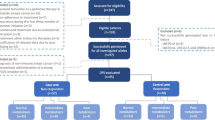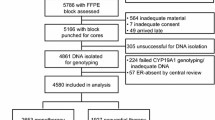Abstract
CYP19A1 gene product aromatase (CYP19A1) is a 58-kDa protein and belongs to the member of the cytochrome P450 superfamily, which facilitates the bioconversion of estrogens from androgens. Single-nucleotide polymorphisms (SNPs) of CYP19A1 affect the activity of the enzyme and have been implicated in the association of estrogen-dependent disease, prognosis, therapeutic efficacy, and toxicity of third-generation aromatase inhibitors (AIs). Based on ethnicity, the frequency distribution of CYP19A1 alleles will differ, and until now, no data are available for Indians. Using qRT-PCR with TaqMan assays, the frequencies of functionally important polymorphic variants of CYP19A1 gene were determined in 163 healthy subjects of South Indian origin. The observed frequencies of the CYP19A1 minor alleles for the SNPs rs4646 (T), rs10046 (T), rs700519 (T), rs700518 (G), rs727479 (G), rs4775936 (T), rs10459592 (G), rs749292 (A), rs6493497 (T), and rs7176005 (A) are 41.1 (35.8–46.4), 20.0 (15.6–24.3), 33.7 (28.6–38.9), 17.8 (13.6–21.9), 25.8 (21.0–30.5), 19.9 (15.6–24.3), 33.7 (28.6–38.9), 24.9 (20.2–29.5), 35.9 (30.7–41.1), and 35.9 (30.7–41.1), respectively. Strong linkage disequilibrium existed between CYP19A1 SNPs, and sixteen different haplotype structures with a frequency >1 % were derived from all the 10 SNPs tested. The most common being the haplotype (H1) GCTATCTGTG with a frequency of about 17.8 %. Gender-specific assessment showed significant difference in the allele frequency for rs749292 (p < 0.04), and greater inter-ethnic variation was detected in the distribution of CYP19A1 variants except for rs727479. Our results could provide preliminary insight for further pharmacogenetic investigations of AIs as well as for subsequent molecular epidemiological studies on the contribution of these variants to the occurrence and development of estrogen-dependent disease in South Indians.

Similar content being viewed by others
References
Simpson ER, et al. Aromatase cytochrome P450, the enzyme responsible for estrogen biosynthesis. Endocr Rev. 1994;15:342–55.
Bulun SE, Sebastian S, Takayama K, Suzuki T, Sasano H, Shozu M. The human CYP19 (aromatase P450) gene: update on physiologic roles and genomic organization of promoters. J Steroid Biochem Mol Biol. 2003;86:219–24.
Bulun SE, Takayama K, Suzuki T, Sasano H, Yilmaz B, Sebastian S. Organization of the human aromatase p450 (CYP19) gene. Semin Reprod Med. 2004;22:5–9.
Wang L, et al. Functional genetic polymorphisms in the aromatase gene CYP19 vary the response of breast cancer patients to neoadjuvant therapy with aromatase inhibitors. Cancer Res. 2010;70:319–28.
Ma X, et al. Association between CYP19 polymorphisms and breast cancer risk: results from 10,592 cases and 11,720 controls. Breast Cancer Res Treat. 2010;122:495–501.
Berstein LM, et al. CYP19 gene polymorphism in endometrial cancer patients. J Cancer Res Clin Oncol. 2001;127:135–8.
Gulyaeva LF, et al. Comparative analysis of SNP in estrogen-metabolizing enzymes for ovarian, endometrial, and breast cancers in Novosibirsk, Russia. Adv Exp Med Biol. 2008;617:359–66.
Paynter RA, Hankinson SE, Colditz GA, Kraft P, Hunter DJ, De Vivo I. CYP19 (aromatase) haplotypes and endometrial cancer risk. Int J Cancer. 2005;116:267–74.
Tao MH, et al. Polymorphisms in the CYP19A1 (aromatase) gene and endometrial cancer risk in Chinese women. Cancer Epidemiol Biomarkers Prev. 2007;16:943–9.
Goodman MT, Lurie G, Thompson PJ, McDuffie KE, Carney ME. Association of two common single-nucleotide polymorphisms in the CYP19A1 locus and ovarian cancer risk. Endocr Relat Cancer. 2008;15:1055–60.
Kado N, et al. Association of the CYP17 gene and CYP19 gene polymorphisms with risk of endometriosis in Japanese women. Hum Reprod. 2002;17:897–902.
Vietri MT, et al. CYP17 and CYP19 gene polymorphisms in women affected with endometriosis. Fertil Steril. 2009;92:1532–5.
Modugno F, et al. Allelic variants of aromatase and the androgen and estrogen receptors: toward a multigenic model of prostate cancer risk. Clin Cancer Res. 2001;7:3092–6.
Onsory K, et al. Hormone receptor-related gene polymorphisms and prostate cancer risk in North Indian population. Mol Cell Biochem. 2008;314:25–35.
Suzuki K, et al. Genetic polymorphisms of estrogen receptor alpha, CYP19, catechol-O-methyltransferase are associated with familial prostate carcinoma risk in a Japanese population. Cancer. 2003;98:1411–6.
Riancho JA, Valero C, Naranjo A, Morales DJ, Sanudo C, Zarrabeitia MT. Identification of an aromatase haplotype that is associated with gene expression and postmenopausal osteoporosis. J Clin Endocrinol Metab. 2007;92:660–5.
Baghaei F, et al. The CYP19 gene and associations with androgens and abdominal obesity in premenopausal women. Obes Res. 2003;11:578–85.
Chace C, et al. Variants in CYP17 and CYP19 cytochrome P450 genes are associated with onset of Alzheimer’s disease in women with down syndrome. J Alzheimers Dis. 2012;28:601–12.
Iivonen S, et al. Polymorphisms in the CYP19 gene confer increased risk for Alzheimer disease. Neurology. 2004;62:1170–6.
Ghosh J, Joshi G, Pradhan S, Mittal B. Potential role of aromatase over estrogen receptor gene polymorphisms in migraine susceptibility: a case control study from North India. PLoS ONE. 2012;7:e34828.
Shimodaira M, et al. Association study of aromatase gene (CYP19A1) in essential hypertension. Int J Med Sci. 2008;5:29–35.
Dunning AM, et al. Polymorphisms associated with circulating sex hormone levels in postmenopausal women. J Natl Cancer Inst. 2004;96:936–45.
Haiman CA, et al. Genetic variation at the CYP19A1 locus predicts circulating estrogen levels but not breast cancer risk in postmenopausal women. Cancer Res. 2007;67:1893–7.
Tworoger SS, et al. Association of CYP17, CYP19, CYP1B1, and COMT polymorphisms with serum and urinary sex hormone concentrations in postmenopausal women. Cancer Epidemiol Biomarkers Prev. 2004;13:94–101.
Hadfield KD, Newman WG. Pharmacogenetics of aromatase inhibitors. Pharmacogenomics. 2012;13:699–707.
Turkistani A, Marsh S. Pharmacogenomics of third-generation aromatase inhibitors. Expert Opin Pharmacother. 2012;13:1299–307.
Ma CX, et al. Human aromatase: gene resequencing and functional genomics. Cancer Res. 2005;65:11071–82.
Lee SJ, Kim WY, Choi JY, Lee SS, Shin JG. Identification of CYP19A1 single-nucleotide polymorphisms and their haplotype distributions in a Korean population. J Hum Genet. 2010;55:189–93.
Arun Kumar AS, et al. Haplotype structures of common variants of CYP2C8, CYP2C9, and ADRB1 genes in a South Indian population. Genet Test Mol Biomarkers. 2011;15:407–13.
Umamaheswaran G, Praveen RG, Arunkumar AS, Das AK, Shewade DG, Adithan C. Genetic analysis of OCT1 gene polymorphisms in an Indian population. Indian J Hum Genet. 2011;17:164–8.
Krishnakumar D, et al. Genetic polymorphisms of drug-metabolizing phase I enzymes CYP2E1, CYP2A6 and CYP3A5 in South Indian population. Fundam Clin Pharmacol. 2012;26:295–306.
Umamaheswaran G, et al. Inter and intra-ethnic differences in the distribution of the molecular variants of TPMT, UGT1A1 and MDR1 genes in the South Indian population. Mol Biol Rep. 2012;39:6343–51.
Umamaheswaran G, Krishna Kumar D, Adithan, C. Distribution of genetic polymorphisms of genes encoding drug metabolizing enzymes and drug transporters—a review with Indian perspective. Indian J Med Res. 2013 (In Press).
Soni A, et al. Association of androgen receptor, prostate-specific antigen, and CYP19 gene polymorphisms with prostate carcinoma and benign prostatic hyperplasia in a north Indian population. Genet Test Mol Biomarkers. 2012;16:835–40.
Samson M, Rama R, Swaminathan R, Sridevi V, Nancy KN, Rajkumar T. CYP17 (T34C), CYP19 (Trp39Arg), and FGFR2 (C906T) polymorphisms and the risk of breast cancer in south Indian women. Asian Pac J Cancer Prev. 2009;10:111–4.
Suryanaryana VV, Rao L, Kanakavalli MK, Padmalatha VV, Deenadayal M, Singh L. Role of CYP17 and CYP19 polymorphisms in idiopathic recurrent miscarriages among South Indian women. Reprod Biomed Online. 2007;14:341–7.
Reich D, Thangaraj K, Patterson N, Price AL, Singh L. Reconstructing Indian population history. Nature. 2009;461:489–94.
Colomer R, et al. A single-nucleotide polymorphism in the aromatase gene is associated with the efficacy of the aromatase inhibitor letrozole in advanced breast carcinoma. Clin Cancer Res. 2008;14:811–6.
Garcia-Casado Z, et al. A polymorphism at the 3′-UTR region of the aromatase gene defines a subgroup of postmenopausal breast cancer patients with poor response to neoadjuvant letrozole. BMC Cancer. 2010;10:36.
Fasching PA, et al. Single nucleotide polymorphisms of the aromatase gene (CYP19A1), HER2/neu status, and prognosis in breast cancer patients. Breast Cancer Res Treat. 2008;112:89–98.
Park IH, et al. Single nucleotide polymorphisms of CYP19A1 predict clinical outcomes and adverse events associated with letrozole in patients with metastatic breast cancer. Cancer Chemother Pharmacol. 2011;68:1263–71.
Ferraldeschi R, et al. Polymorphisms of CYP19A1 and response to aromatase inhibitors in metastatic breast cancer patients. Breast Cancer Res Treat. 2012;133:1191–8.
Straume AH, Knappskog S, Lonning PE. Effect of CYP19 rs6493497 and rs7176005 haplotype status on in vivo aromatase transcription, plasma and tissue estrogen levels in postmenopausal women. J Steroid Biochem Mol Biol. 2012;128:69–75.
Kadouri D, et al. Effect of single-nucleotide polymorphisms in the CYP19 gene on response to Letrozole among breast cancer patients (Supplement). J Clin Oncol. 2008;26:22096.
Mao JJ, et al. Association of functional polymorphisms in CYP19A1 with aromatase inhibitor associated arthralgia in breast cancer survivors. Breast Cancer Res. 2011;13:R8.
Acknowledgments
The study was financially supported by Indian Council of Medical Research (ICMR), New Delhi (Grant Order No. 53/17/2003-BMS dt.12.03.2007). We thank and deeply appreciate the effort of Mr. Srinivasa Rao K, Miss. T. Padmapriya, and Mr. A.S. Arunkumar, PhD Scholars, Department of Pharmacology, JIPMER, in recruiting the study subjects as well as in DNA extraction.
Conflict of interest
The authors declare no conflict of interest.
Author information
Authors and Affiliations
Corresponding author
Rights and permissions
About this article
Cite this article
Umamaheswaran, G., Dkhar, S.A., Kalaivani, S. et al. Haplotype structures and functional polymorphic variants of the drug target enzyme aromatase (CYP19A1) in South Indian population. Med Oncol 30, 665 (2013). https://doi.org/10.1007/s12032-013-0665-x
Received:
Accepted:
Published:
DOI: https://doi.org/10.1007/s12032-013-0665-x




